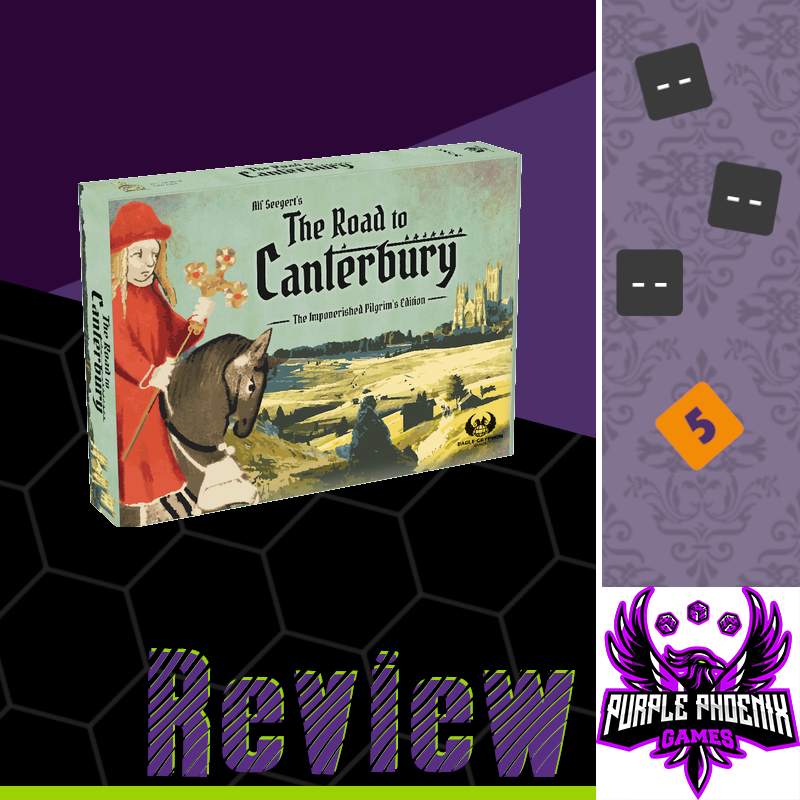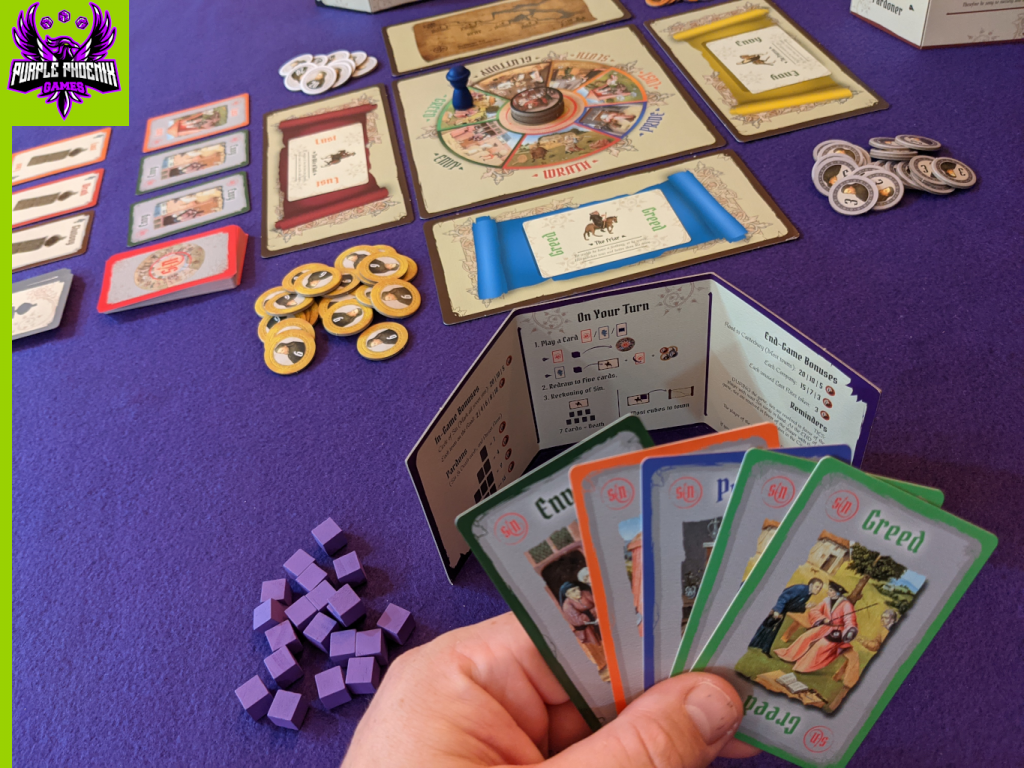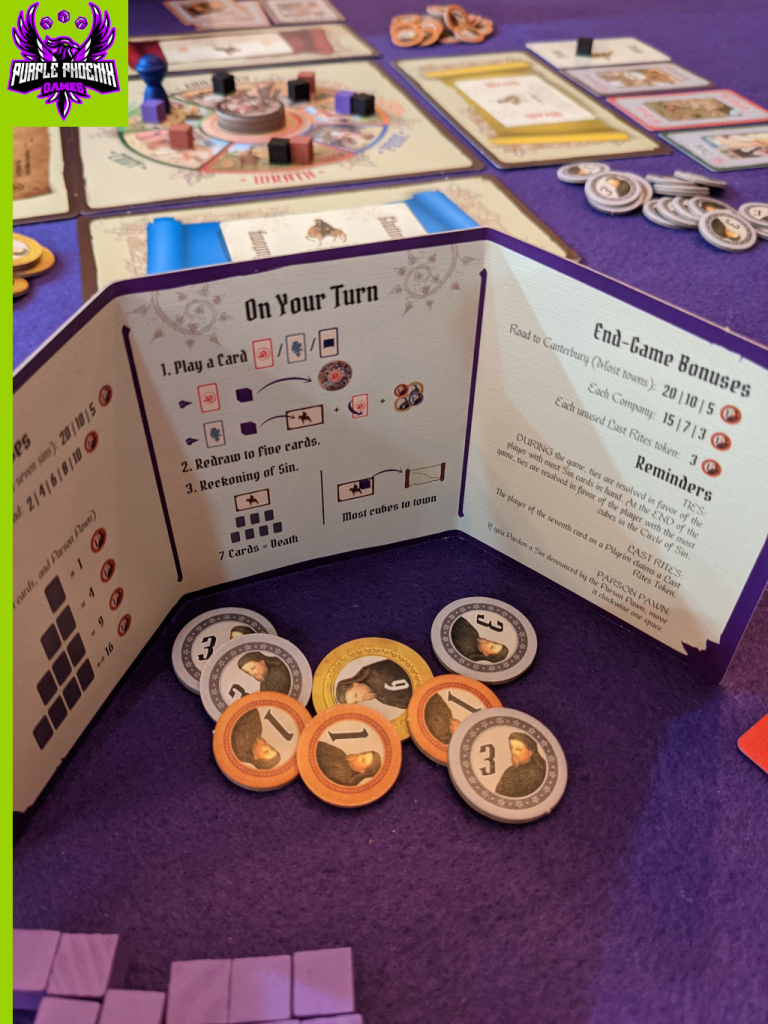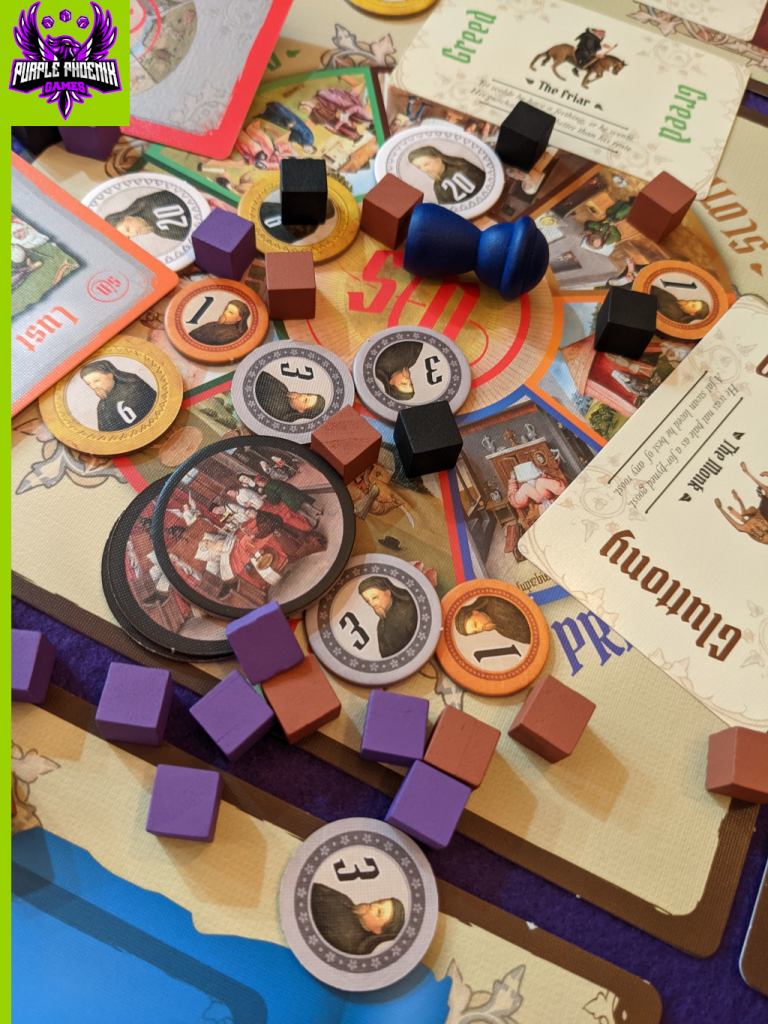
I am not a sinless man. In fact, it’s been years since I’ve been to confession, and at this point I’m afraid I would be there for hours just spilling the beans. I know many pious people, but alas, I am not one. However, I do appreciate those that attempt to live that holy life. It takes a lot of guts and a lot of hard work. I guess I’m a little slothy when it comes to that, personally. Anyway, I know of the Seven Deadly Sins, Cardinal Sins, Capital Vices, or whatever you’d like to call them. In fact, I really like the movie Seven – I think it’s great! That said, let’s find out just “what’s in the box?”
| The Road to Canterbury 2e (2021) | Eagle-Gryphon Games |
| 2-3 Players | 60 minutes |
| Ages 10+ | BGG Weight – 2.25 / 5 |
The Road To Canterbury is a game of medieval hand management and area influence. In it players are false pardoners stalking the road to the city of Canterbury as pilgrims make their way there from London. As their companies run across these pardoners, they are offered the chance to purchase pardons – salvation and forgiveness for their sins. However, these pardoners are also keen to help the pilgrims along the path of sin, thus making their faux pardons worth even more money! The pardoner who ends the game with the most money will win along The Road to Canterbury.
DISCLAIMER: We were provided a copy of the Impoverished Pilgrim Edition (2nd edition) game for the purposes of this review. This is a retail copy of the game, so what you see in these photos is exactly what would be received in your box. I do not intend to cover every single rule included in the rulebook, but will describe the overall game flow and major rule set so that our readers may get a sense of how the game plays. For more in depth rules, you may purchase a copy online or from your FLGS. -T
To setup, follow the rulebook, as there are many components to track. The main areas are the Circle of Sin mat that holds the Parson pawn, the decks area that hold the various decks of cards from which players will be drawing, and each player’s personal area where players will hide their earnings and hand of cards behind the privacy screen. Once all is setup somewhat correctly, it should look similar to the photo below. Warning: When I set this up and took the photo, I neglected to realize the red company and the map tiles were translated to the wrong spaces, so just switch those.

The Road to Canterbury is a game of rounds, and each round players will be taking similar steps: Play One Card, Redraw, Perform a Reckoning of Sin. Players will have access to three different types of cards that can be played during the Play One Card phase: Sin cards (five of which are dealt at setup), Pardon cards, and Relic cards. During this phase, the active player can play a Sin card to one of the active Pilgrims to tempt them towards committing that sin. The first time the player adds a Sin card to a Pilgrim, they place one of their corruption cubes on the matching sin on the Circle of Sin. Alternatively, they may play a powerful Relic card that offers adjustments to the rules, or has some interesting results. When a player feels that enough Sin cards of a specific type have been played on a Pilgrim, they may opt to play a matching Pardon card in order to gain precious coin to their pockets. Each Pardon card essentially pardons ALL the sins of that type on the Pilgrim, and the player then collects coins exponentially for a larger total of matching Sin cards on that Pilgrim. If the Parson is currently sitting on the matching sin, the pardoner receives extra coin for it being an especially egregious sin in the eyes of the church. Each time the Pilgrim is pardoned, the pardoner places one of their corruption cubes upon the Pilgrim.
After the active player has played their card, they must Redraw their hand back to five cards, choosing to draw from the Sin, Pardon, or Relic offerings. Some Sin cards may be drawn that are Death Approaches cards. When these surface, they are immediately attached to the Pilgrim whose color matches that of the drawn card’s border color. This essentially eats up a slot on the Pilgrim that could be used for a Sin card to be pardoned.
Once the player has redrawn cards to their hand they must next Perform a Reckoning of Sin. The active player assesses each active Pilgrim to see if they have seven or more cards attached to them. If so, that Pilgrim will perish from the “deadly” sins. Whichever player has placed the most number of corruption cubes upon the Pilgrim is considered present at time of death and will receive credit for the sending to the heavens. They move one of the cubes upon the Pilgrim to the first space on the map tile, earning bonus points and a Last Rites token. Last Rites may be performed immediately to take another turn, or may be held until the end of the game for a 3 VP bonus per token. The most interesting aspect of a Pilgrim dying is the fact that their card now becomes a permanent placeholder underneath their company’s colored banner. So the next Pilgrim to enter play for that company will need only six additional cards to kick the bucket, and so on.
Play continues in this fashion of players taking turns through their three phases. The game ends when all the spaces on the map tile are filled with cubes. Bonus points are counted, coins are added, and the player with the most money/highest score is the winner! The best temptress and pardoner this side of Yorkshire!

Components. I have no experience with the first edition of The Road to Canterbury, so unfortunately I cannot compare and contrast components. However, I have seen many photos and even checked out a review video or two. What I can say about components is that this edition has refreshed the look of nearly everything, and so much for the better. Instead of boring plain cards, there’s just a little more decoration. Not so much to be invasive or distracting, but very tasteful. The component quality throughout is quite stellar. There’s a lot of cardboard in this box, and it all looks and feels great. I do quite like the art style, even though it’s all medievall-y and too artsy for my normal preference. All in all a great quality box of game.
So like I said, I have no experience with this game prior to receiving it and playing through it now. It certainly doesn’t feel like a 10-year-old game, nor does it really feel like many of the Alf Seegert games I have played in the past. Neither of these points are bad at all, just some thoughts I had.
It should be obvious by my ratings graphic that I dig this game a lot. I have nothing like it in my collection, and I am super excited to really bring this out with different types of gamers to see how it fares (once the COVID is no longer an issue, of course). I see this being a hit with my family, who enjoys a lot of take that style games. I see this being a hit with my more thinky gamer friends, because there are just so many juicy choices to be had every turn. I can see this even being a hit with my more gateway friends, because it isn’t terribly heavy, has some humor in it, and I can see the prospect of sowing sin and killing off innocent Pilgrims being attractive to some of my more morbid friends.
For me, I love the ability to take every turn and make important decisions. I try to make every turn meaningful to my agenda, but tactical with what may be at my disposal at the time. When should I play this Relic? Why is named something ridiculous? Should I wait a while longer to pardon this sin, or should I pile on another and then pardon next turn? Ooh, but what if my opponent has the same Pardon card. Am I truly happy that this poor Wife of Bath is about to kick it? GAAHHHHH!
Now it’s no secret that I am a big fan of Dr. Seegert’s games, as I have previously reviewed Fantastiqa and Haven with very high ratings. So, I was not at all surprised that I would love this one as well. It offers so many great choices, looks great on the table, fills a unique void that was present in my collection, and can be played with various types of gamers, even though it is designed for two or three players total. Purple Phoenix Games gives this one an unapologetic 5 / 6. I don’t think it will break into my Top 10, but I certainly won’t rule it out quite yet. More plays with different types of gamers may change my mind on that statement, and I eagerly await my plateful of crow. So if you are like me in your gaming preferences, check out this version of The Road to Canterbury. Let me know how often you tend to grab Relics too, because I feel like I need to utilize them more, but it is so hard to pass up a Sin or Pardon. I Lust after them so very badly.

